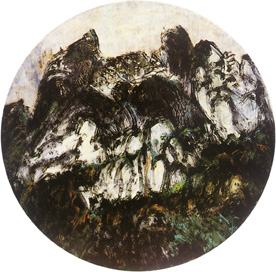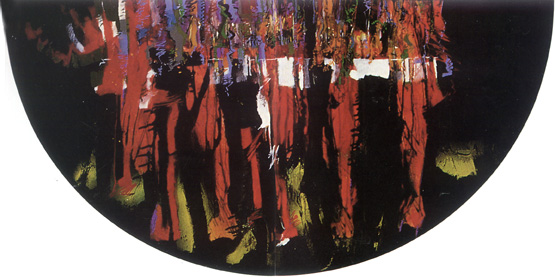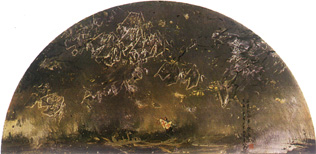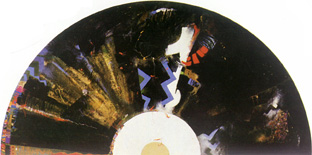This time it was in my hometown of Shanghai that I met Carlos Marreiros. He greeted me cheerfully and said outright: "Your calligraphy is fantastic. Even your drawing looks like calligraphy." He was referring to the tribute that I had paid to him in Macau in his beautiful Chinese album, full of other tributes offered by friends from several countries. They were written horizontally in ink, almost all of them in English, French, Portuguese, or Spanish. As for mine, a small Chinese picture, it was rendered with simple brush-strokes. To fill the remaining space, which to me seemed huge, I wrote some characters in the Kuanco style. I followed the conventions of style and was thus happy with my rendering. Chinese painters prefer to paint according to the rules: 'between the resemblances and the differences', and mine also adhered to these principles. Fortunately, this detail was noticed by the eye and sensitivity of a foreign appreciator.
 Thousand Mountains. Acrylic on wood, △ 120 cm. 1993.
Thousand Mountains. Acrylic on wood, △ 120 cm. 1993.
To European eyes, Chinese calligraphy is as incomprehensible as the writing of the gods having as its features four main modes - Zeng, Zhuan, Xing, and Cao - and multiple styles. It is an art which is unique to China and only accessible to those who have plunged deeply into the seas of this millennial culture. Consequently, I was greatly surprised to discover that the distinctively characteristic and avant-garde works of Carlos Marreiros exhibited at the Palace of Fine Arts in Shanghai, were covered in Chinese characters. These were multicolored and had a very spontaneous organic connection. They produced inside me very special emotions and had a great impact on my sensibility. This led-me to a journey of deep meditation. In a discussion of the works of Carlos Marreiros, many of my colleagues asked him: "Why is it that the characters which we find in your paintings do not follow the syntactic rules?" - to which he replied; "Because they have only iconic value." "But do you understand these characters?" insisted another: "I do not. It is nothing more than adopting the strength, the rhythm, and the elegance which they can express," he concluded.
Nevertheless, Carlos Marreiros is not restricted to mere superficial copying of these characters. On the contrary, he creates a strong pictorial language through the harmonious arrangement of strokes and shapes, which remind one of the mountain rocks and the sea currents. I would not be exaggerating if I said his calligraphy in the Xincao style succeeds in evoking the beauty of ivy creeping over a rugged wall.
His pictorial language, resulting from the meeting of the values of two cultures - Eastern and Western, has not yet found any geographical barriers. I am reminded here of my visit to Macau in 1991 at the invitation of the Institute Cultural de Macau, when I participated in an exhibition together with Li Re and Song Mang. Naturally, we paid a courtesy visit to Carlos Marreiros, then the President of the ICM, and talked with him through two interpreters - from Cantonese and Portuguese. Despite our realization of the great distance between our two cultures, what consoled us was the fact of having spoken a pictorial language, which being universal, eliminated the distances and made us friends.
It is possible to say that even before the Period of Discoveries, several nations had started searching for one another, anxious to break through the limits - the same way that today people look for the existence of extra-terrestrials. It was from this quest that the achievements of Colombo, Fernão de Magalhães, and Zheng Ho - pioneers of the creation of modem civilization, were born. In our times that quest has not yet stopped; on the contrary, its continuation follows a faster rhythm and more elevated from the cultural point of view. Aware of this, Carlos Marreiros said: "Interchange is the major vehicle for cultural development. Going against interchange is the same as going against culture." Like a pilgrim from the West, he drinks deeply the essences of Eastern culture - seeking out not only its resemblances, but its differences. Historically, this also happened with Marco Polo and Mateus Ricci: "They made a great contribution to China - thus to universal culture.", wrote the master-writer Le Chun. The meeting of distinctive cultures, by complementing each other, is sometimes an act of creation. Life and history have proved that there was a fundamental contribution from the "wind of Westernization" in the process of establishing an avant-garde 'plastic' conception of China. It was exactly that wind that brought us artists like Xun Pei Hong, Ling Pong Mia, and Liu Hai Xu (still alive); heroes of our national culture. The implantation of the Western plastic conception in China followed an arduous course through the centuries. The painter J. Castiglione is an example. He was despised by the palace mandarins and, at the same time, venerated by Kang Iu-vai; a pioneer of the democratic revolution in China. Actually, without Western influence, it would be impossible to imagine how long the millennial civilization of China would last. In reciprocation, we know how influential our culture is on Western culture. An example of this is Carlos Marreiros.
Carlos Marreiros incorporates his Oriental feeling into his work: Earrings of the Empress ; 'Earrings of Pui I'; Yellow River ; Xian and several San Sui, through them expressing his deep love of his origins. As a matter of fact, the roots of his neoorientalism are in Western soil. But at the same time, he embodies the philosophical values of our times, in which subconscious and primitive spontaneity are very important. From these horizons, Carlos Marreiros dares us, with spurts of spontaneity and the flow of the subconscious, to interpret with an automatic pulse, the route which emanates from the inside looking outwards for a language in which natural sensuality is laid bare. He exercises on the canvas, together with his young daughter, to experiment in puerile instantaneousness, which is different from a priori: "Painting has a life of its own, which I try to manage", he said. What he said is one of the most discussed concepts in terms of the philosophy of art. Although Pollock said, and he was right, that the essential question of modem painting is to set the boundaries, in practice any kind of art emanates from the feeling its land gives to it and from the renovation of its traditional legacy. In this context, Carlos Marreiros embodies his conception with evocative, exuberant figurations - without repetition of the modernist philosophy. In his use of gradation and special effects derived from Eastern techniques and materials; such as rice paper, the Chinese brush and ink, Carlos Marreiros transmits an emotion with a very unique identity. One of his 'San Sui', belonging to Mio Pang Fei's collection, is proof of this.
The state of Western contemporary painting became recently the subject of daily discussion among my colleagues. The perspective taken by the modernist over the last hundred years, both in the East and in the West, is now stagnating in decadence and is of great concern. Many people are questioning, with perplexity, the value of modem painting and some have come to the conclusion that 'modem painting is rubbish'. Inevitably painting, no matter what style, will in reality lose life if it exceeds its own values. To defy this reality, Carlos Marreiros proclaims: "Let us show the world our neo-orientalism". This is a common aim shared by many Asian painters. Carlos Marreiros, being a 'connoisseur' of Western plastic arts, said that even in Paris, a city with a renowned artistic ambience, it was not as easy anymore to find quality works. In the galleries, only occasionally does one see a high degree of quality and talent. On the contrary, commercial mediocrity and repetitiveness are evident in most works. There is a Chinese saying that: "Real pearls can be mixed with fishes eyes". In comparison to the West, Asia is still in the premodernist phase - its creative spirit is sometimes imprisoned by traditional inertia. However, taking into consideration the direction already taken, and the premonitory dawn now coming to the modem civilization of the Orient, new horizons are beginning to be viewed. The condition for this improvement is the breaking away from the conservative and monodirectional mentality towards receptivity to all expressions - as a probable indicator of our times. In this context, Carlos Marreiros, who accentuates this forceful idea, is indifferent to the lethargy of others and has already started to fight for his cause. The paintings of the next century must see the abandonment of slavish processes - both in the East and the West, and break free from immobility.

Urban I. Macau, from the series Fans.
Acrylic on wood, A 120 cm, 1993.

The Arrival (of the Portuguese), from the series Fans.
Acrylic on wood, A 120 cm, 1993.
As a sequel to the great success made by the exhibition of the paintings of Carlos Marreiros and Mio Pang Fei at the Palace of Fine Arts in Shanghai, the University of Shanghai appointed them Visiting Lecturers to its National Academy of Fine Arts. At the solemn ceremony held on the occasion of his honore doctorate, Carlos Marreiros made a speech entitled "200 Years of Painting in Macau" which gave us an appreciation of the fruitful culture of Macau which had until then been unknown to us. What surprised us, was that Macau had produced a number of astonishing painters. George Chinnery, an English painter of the 19th century, travelled all over the world and eventually settled down in Macau. He modelled his works in a subtle classical style, reaching admirable purity and perfection. His best Chinese disciple, Lan Qua, had a natural talent and became master of an unique technique. He was the first Chinese to learn how to paint in a Western style. He founded a studio in Canton, known internationally for producing paintings of romantic views of Macau; in the 'China Trade' style. Marciano Baptista and, already in our century, the Russian architect George Smirnoff, transposed their mysterious inspirations to serene, elegant watercolours. In a more contemporary vein, Luís Demée, Kwok Se, Conceição Júnior, Kwok Woon, Ung Vai Meng have, each of them, secured a place of their own by their distinctiveness. Of special interest is Mio Pang Fei, for whom Carlos Marreiros has a great admiration, who has succeeded in synchronizing intimate strength and evocative power with the artistic legacy of the Tang and Song dynasties. This has been achieved without neglecting the intensity of German Expressionism and Antoni Tapies. Mio, with his mature talent, has already earned an international reputation.
As a contemporary artist imbued with veneration and a. deep love for Macau, Carlos Marreiros devotes himself to a range of creative activities. "Macau, a city of culture, has one poet to every square metre and is an excellent milieu for music, dance, theatre, opera, photography - indeed for all the genuine manifestations of culture." This manifestation of culture demonstrates that Macau has emerged from its lethargy and is about to experience a period of flourishing development; with Carlos Marreiros an eager contributor. He was, and still is, an untiring champion of the preservation of Macau's architectural heritage which he wants to continue to co-exist with modern buildings, to keep the contrasting features of the city. It is this unique identity which Macau can commemorate for the world. Carlos Marreiros was also the founder of the 'Círculo dos Amigos da Cultura de Macau', with which many promising painters of the territory are affiliated, and the Circle has become known, outside Macau, throughout Asia. To promote the unique image of Macau and its potential for artistic endeavour, this association has already held exhibitions in Japan, Taiwan, Singapore, India, Malaysia, Korea, and Hong Kong; thus strengthening the ties with the outside world and bringing freshness to a new mentality.

The Old Man's Fan, from the series Fans.
Acrylic on wood, A 120 cm, 1993.
Carlos Marreiros likes to say, quoting the geomancy masters: "Macau is a land of Lotus Flowers." How sentimental is this metaphor! In China, the lotus flower symbolizes happiness, harmony, and purity. With this love of the lotus flower, Carlos Marreiros conciliates his exhuberant joy with his instinct to create. One could say that he, my Portuguese friend, epitomizes the lotus flower; with his roots in Eastern soil, he spreads forth the fragrance of his art.
*Painter and former Professor of Art at the Universities of Shangai and Haerbin. Has a great number of works published, namely Contemporary Chinese Painters, Dang Qichan and His Thoughts about Erudite Painting; Civilization and Weakness.
start p. 140
end p.